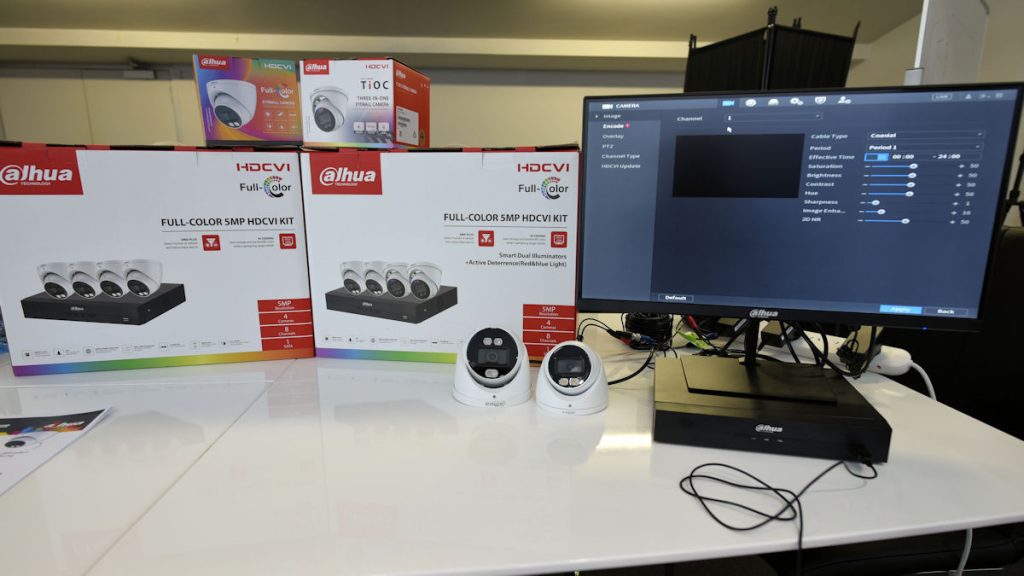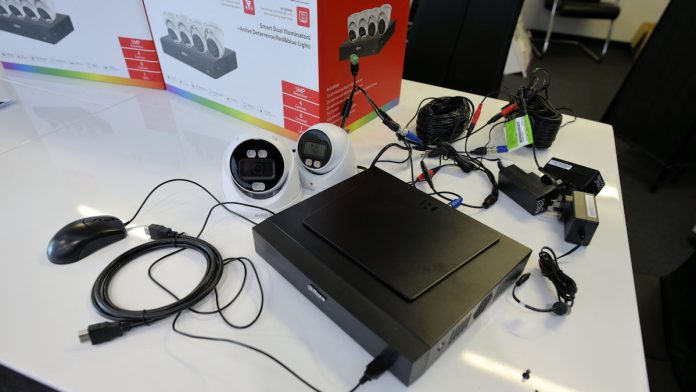Dahua 5MP HDCVI Kit Desktop Review.
Dahua 5MP HDCVI Kit – Dahua’s 5MP HDCVI kits allow installers to support customers who have existing analogue CCTV systems and want to retain their existing cabling, while accessing the latest active deterrence functionality from Dahua’s newest cameras.
We got a demo of setup and operation of one of the kits at LCS’s Sydney office recently and it was hard not to be impressed with the simplicity, affordability, and functionality of the solutions. Something I noted later was that we spent a fair bit of time talking about the system and then when it was time to undertake the demo, the setup and commissioning process was a snap.
There are compelling reasons end users might choose to go with HDCVI digital analogue CCTV solutions, including affordability, simple installation thanks to retention of existing RG59 coaxial cabling, as well as strong low light performance and a lack of latency.
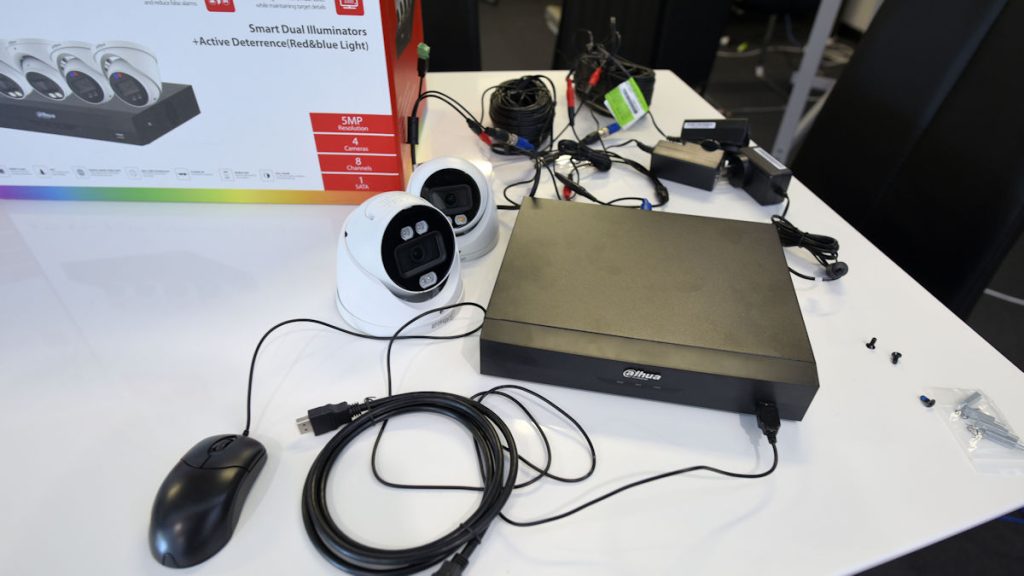
From the point of view of installers, the attractions are similar – these kits are a very appealing way to pull SME customer’s out of the 1990s without scaring them with too much complexity and cost. Installers will also find installation and commissioning simple – there’s no need to re-terminate coax, run cable, or conduct a system-lifetime battle with networks.
There are 2 kits available, one of which includes 4 Dahua colour HDCVI eyeball cameras, the other which comes with 4 Dahua 5MP Smart Dual Illuminator Active Deterrence HDCVI eyeball cameras – these latter offer TiOC type functionalities. Supporting these cameras is an 8-input Dahua NVR with a single 2TB SATA drive.
At the heart of each kit is Dahua’s DH-XVR5108HS-4KL-I3, an 8-channel penta-brid 4K-N/5MP, 1U 1HDD, WizSense NVR supplied with a 2TB drive and capable of supporting HDDs up to 8TB. This NVR offers H.265+/H.265 dual-stream video compression, full-channel AI coding, and supports HDCVI/AHD/TVI/CVBS/IP video inputs.
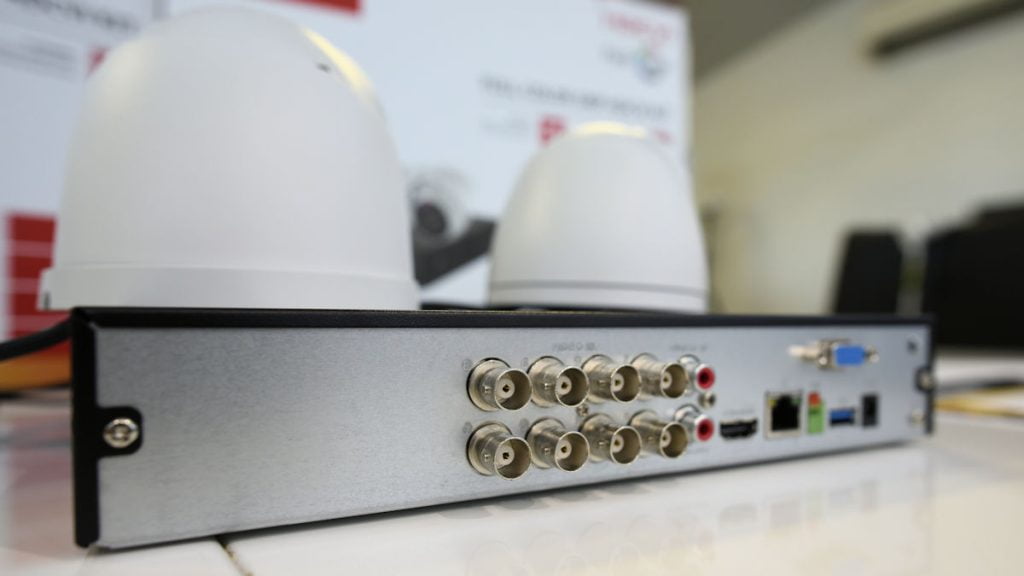
The unit supports up to 8 channels of digital analogue for Dahua Perimeter Protection functions, 8 channels for Dahua SMD Plus, and 2 channels for face recognition. There are also IoT and POS functionalities, and you can bring 16 IP cameras with resolutions up to 8MP into the NVR via a remote switch, giving the unit considerable flexibility for expansion or camera aggregation.
Each kit ships with 4 x 18 metre coax cables (supporting power) along with 4 cameras. The first of the camera options offers 4 x 5MP full-colour HDCVI, IP67 eyeball (turret) cameras with 120dB of WDR, 3D noise reduction, integrated 40m illumination distance, CVI/CVBS/AHD/TVI switching, and a built-in mic (-A). The 2.8mm fixed lens delivers a mid-wide angle of view that’s very flexible and the wide-ish angle is well supported by 5MP resolution, allowing useful digital zooming.
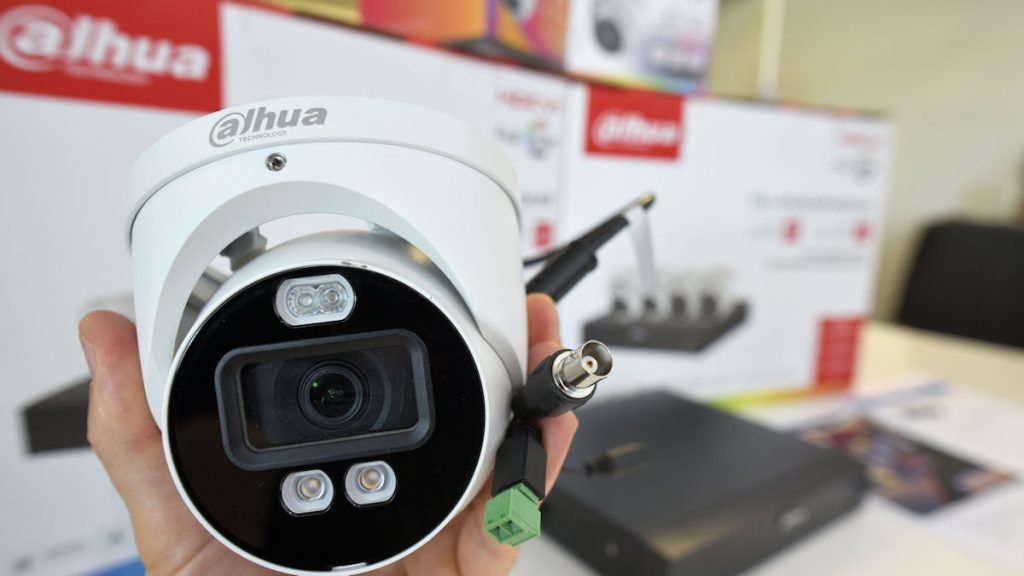
The second camera option is the one we’d go for – it includes 4 x 5MP Dahua Smart Dual Illuminators Active Deterrence HDCVI IP67 eyeball cameras. These have an optional 2.8 or 3.6mm focal length, a superfast aperture of F1.0, as well as 120dB of WDR and 3D noise reduction, along with smart dual illuminators delivering white light and IR to 40 metres, active deterrence with red-blue light, siren and an alarm-out interface.
The camera sports electronic defog, 5 programmable audio warnings offering messages like ‘no parking here’, ‘private land, no entry’, ‘warning, keep off’, simple alarm tones upon intrusion detection, or even a ‘welcome’ message. This camera is a solid unit that can handle an operating range of -40 t0 60C, has an integrated microphone, CVI/CVBS/AHD/TVI switching, 8 privacy masks, a metal case, and a weight of around 700g.
Dahua 5MP HDCVI Kit Use Case
According to LSC’s Rhys Saxon, there are appealing qualities with HDCVI – primarily that it allows installers and end users to retain existing coaxial cabling.
“This makes the job easier and faster for installers and less expensive for end users,” Saxon says. “It’s possible for installers to retain existing coaxial cabling and simply swap out the legacy analogue cameras.
“Alternatively, they can swap out the old analogue cameras for new HDCVI cameras, while at the same time supporting IP cameras that might be installed elsewhere on the site via a switch connected to the NVR over Cat-6, so there’s that IP flexibility, too.
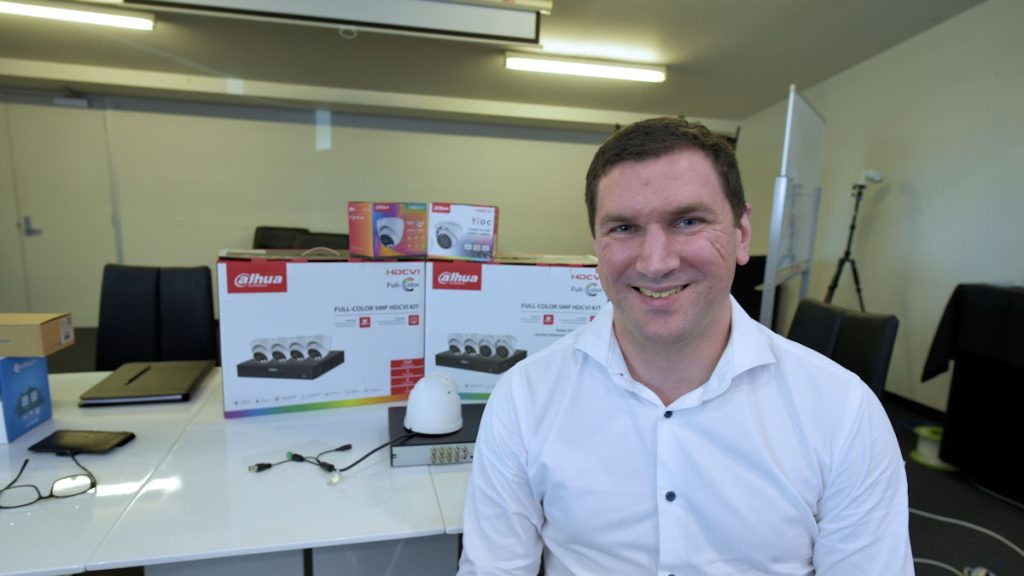
“The kit NVRs ship with hard drives, so they are ready to go out of the box, and while they’re designed to use existing coax, they do ship with 4 x 18m rolls of coaxial cable. This makes them the ultimate plug and play because there are no IP issues to wrestle with,” Saxon explains.
“At the same time, the digital NVR is configured with management software that finds and displays cameras automatically, and allows software programming of cameras and viewing via an app. You can’t get a simpler installation with so much functionality.”
I pick up the NVR unit and turn it over to check the ports, noting that it’s compact and lightweight for an 8-input NVR with a 2TB drive – you could tuck a slim unit like this anywhere. Is there a large market for digital analogue? It’s replacing solutions that must be quite old, I think aloud.
“Yes, there definitely is a market out in the suburbs in metropolitan areas, and in regional areas, too,” Saxon explains. “There are plenty of retail, SME and light industry users who will continue to use a solution that gives them an essential operational overview until it breaks.

“And even if that legacy system does not have a great deal of additional functionality, many users who have never had more capability are happy with this basic monitoring – they may simply want to view the point of sale, the customer carpark, the warehouse, or the reception area from an adjacent office.
“With these Dahua HDCVI kits those sorts of systems, some of which are now reaching end of life, can be upgraded to offer the latest functionality at a minimal cost – it really is an easy sell to cost-conscious customers.
“Certainly, IP is whiz-bang in the minds of users, but it’s not perfect in every way – digital analogue is low latency, strong in low light, matches IP in resolution, delivers all of IP’s functionality in small applications, and it’s very affordable,” Saxon says.

According to LSC’s Peter Mellino, it’s that combination of features and low cost that makes these Dahua kits appealing.
“The quality is excellent, the feature set is excellent – I think the major benefit here is that you can retrofit an existing system and upgrade it to the latest TiOC technology from the point of view of operations, without having to spend much on labour. For some customers that’s the killer – yet this solution makes it difficult for those users to resist an upgrade.
“Dahua HDCVI is so simple to install, it’s simple to operate and uses existing cabling – all this means you can upgrade an end user’s system to offer performance that’s the latest and greatest while saving them lots of money,” Mellino says.
“I think thoughtful installers understand this and can communicate to customers that while IP is available and it certainly has major benefits in many applications, IP is not always necessary, and there are some applications where low latency digital analogue has distinct performance and cost advantages.”
Driving the Dahua 5MP HDCVI Kit
Something you don’t appreciate so much during a desk demo is the fact that installing cameras in the field using existing cabling means that entire aspect of the installation is not required, nor does the installer need to navigate a network – that combination makes installation lightning fast.
In terms of doing a retrofit as an installer you’d take the old analogue cameras out and replace them with these new cameras, disconnect the old DVR and replace it with this new NVR, tighten the BNCs at either end and power up. When it powers up, the system on the NVR finds the cameras, opens into live view, and you can start driving or tweaking camera settings via simple drop-down menus, without needing to undertake any setup other than naming camera views if that’s all you decide to do.
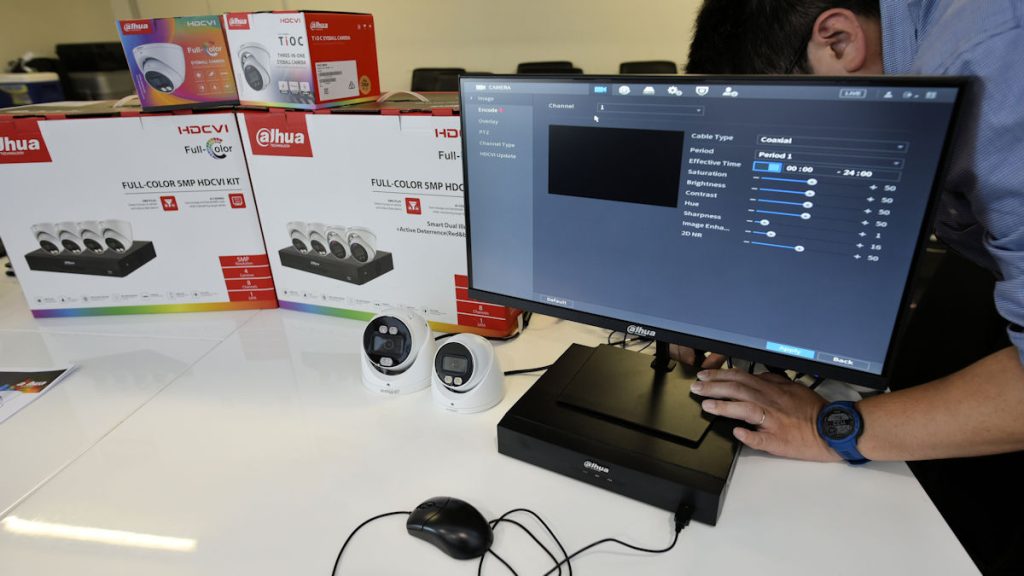
Not surprisingly, setup during our demo is straightforward. Once the hardware is laid out, connected, and powered up, camera views appear in the viewer on the monitor. As we go along, I can see there’s considerable camera control integrated into the software driving this NVR, including image settings, search, alarm, IoT, PoS, AI, and maintenance, as well as network, storage, system, and security functions.
We run through the process, opening camera settings, doing some tweaking, and looking at the AI options. It’s very simple. The thing that jumps out as someone who tests plenty of cameras is that there’s no latency at all. Zero latency seems a bit magical, when you’re used to 300ths of a second lag as a benchmark. Image quality with these Dahua cameras is strong – nice colour rendition, sharpness is decent, too, and I note distortions are modest with this 2.8mm lens.
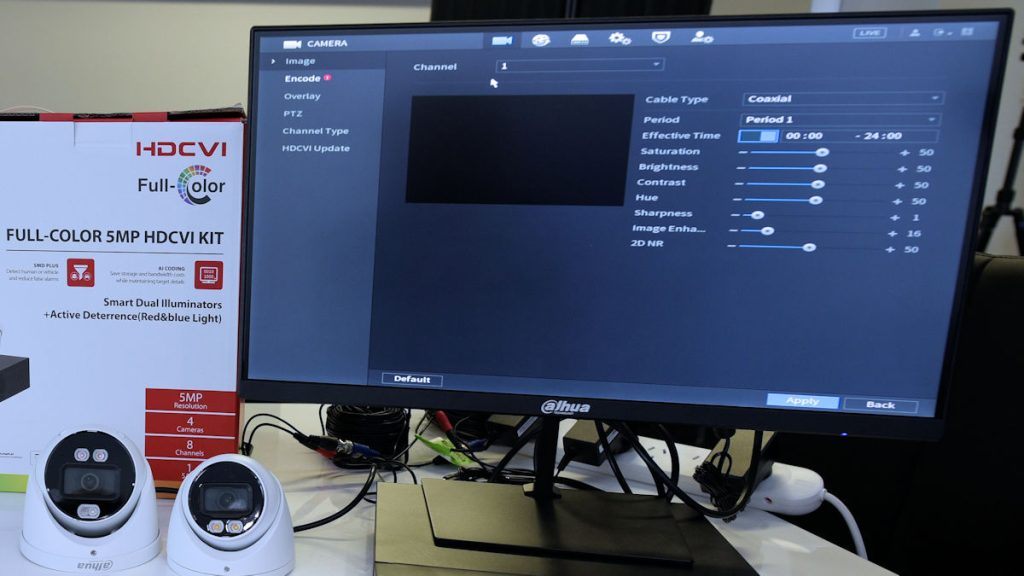
There’s a lot of light in the mezzanine area at LSC, as well as dark areas, and some interesting low kelvin colour tones from certain lights that I am picking up on the Nikon D750. But this Dahua camera contrives to iron all these out in a way that leads to mild resentment later as I’m fiddling with the colour temp slider adjusting my still images between bluey pink and yellow orange in software.
Resolution is solid, colour rendition true, if a little saturated in this internal space with its varying colour temperatures, low light performance in shaded areas is also strong, with no overt sign of amplification noise. At all times digital analogue shows no latency, which can be appealing in some applications. The speed of the setup was impressive, too. HDCVI really is a very simple plug and play.
“You can imagine that anyone upgrading from 540TVL, or a low-resolution early generation IP camera is going to be impressed with this performance – especially given it uses the same cabling as the old cameras,” Saxon says, opening a camera to full screen.
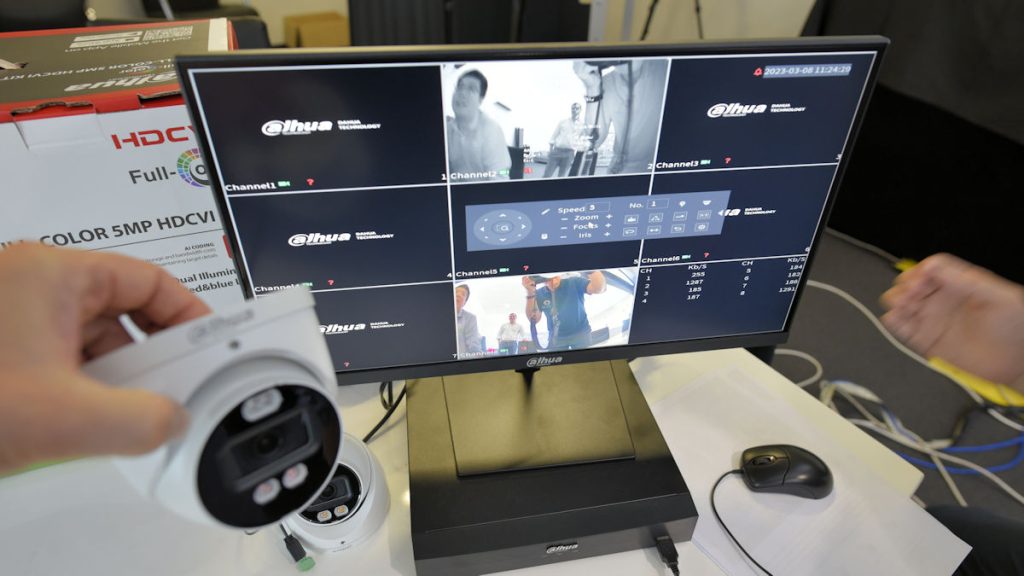
“When you consider there’s no terminating or cabling, that the NVR will automatically detect cameras with nothing more for the installer to do; that you have some great benefits like AI functions, digital searches, a mobile app, integrated lighting and active deterrence functions; and that these IP67 rated cameras that can be installed in any internal or external situation, it’s hard to go past Dahua’s HDCVI kits.”
You can find out more about LSC’s Dahua 5MP HDCVI kits here and read more SEN news here.
“Dahua 5MP HDCVI Kit Desktop Review.”
